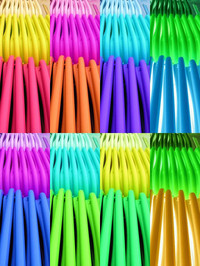
Taking photos in colour is easy, but taking colour photographs with a "wow-factor" requires a little thought. It is vital to be aware just how powerful colour can be in an image and how you can use this to your advantage. Too many different bold colours in an image will invariably produce a confusing and unsatisfying image. It is important to ensure that the hues you are including in your photograph do not compete with each other for attention, but contribute to a well balanced composition.
Make the Most of Colour
- Look for a Dominant Colour: Colourful scenes are usually the ones that inspire photographers to grab their cameras, yet they are often the least likely to result in striking images unless considerable care is taken in the composition. Too many vivid and bright colours will compete for the attention of the viewer and make it difficult to find a focus point. One way of giving a colour photograph a bold, eye-catching quality is to select a subject in which one particular hue completely dominates the scene. This can be achieved by a careful choice of viewpoint, and the way in which the image is framed. The result can be even more spectacular if the other colours in the image are either quite subdued or create a pleasing contrast.
- Use a Colour Contrast: Bold, eye-catching pictures can be almost guaranteed if you know how to make good use of contrasting colours. The most striking effect will be created when just two colours from well separated areas of the colour spectrum are included in the image, such as red against green, or orange against purple. The use of a colour wheel can help you understand the relationship between complementary and contrasting colours. As a general rule, the simplest combinations are the strongest, and the more saturated the colours are, the more eye-catching the result will be.
- Keep it Simple: If there’s a good general rule to follow in photography it is to keep it simple, and this is especially true when working in colour. An image that includes only the essential elements of the scene will invariably have more impact than a complex image with too much detail. Always identify the element in the scene that appeals most strongly to you within the subject, and then consider which of the surrounding details you need to include.
- Create Mood with Colour: One of the most elusive qualities to capture on film is that of mood or atmosphere. Keep in mind how the viewer responds emotionally to colour. Blues and greens evoke a peaceful and relaxed atmosphere, while orange and yellow might create an upbeat, happy feeling. Bright, saturated colours suggest a vigorous and energetic atmosphere, and dark and muted colours suggest a more sombre and introspective response from the viewer.
- Experiment with Filters: If you want to make the most of colour in your images, play with filters. There are a variety of coloured filters on the market that will give an edge to your images. Try fitting a polarizer to the lens to enhance a blue sky and make the clouds stand out more. You can also use filters to cut down on reflections in glass and water.
- Master White Balance: If colour plays an important part in your composition, then you should take the trouble to make sure that the colours are accurate by taking control of the white balance setting. When the white balance is set to Automatic, the camera measures the colour temperature of the light and then sets the ‘white balance’ to produce a neutral result. However, sometimes you don’t want a neutral colour balance. Perhaps you want your scenery to have a golden glow when you photograph it at sunset. In this case you could set the white balance to ‘Daylight’ or ‘Cloud’ for a warmer feel.
- Learn how to Boost Colour in Post-Production: If your images aren’t as eye-pleasing as you had hoped they would be, make sure you know how to boost colour in the digital darkroom. Whether you want a specific colour to leap out or blend in, the Hue/Saturation Tool will help you to get the effect you want. You often don’t need much; just increase the Saturation slider until the image looks nicely pumped up. Be conservative. Always keep in mind that excessive editing will lead to image degradation in the form of noise and posterisation, where colour transition appears in abrupt steps rather than a smooth flow from one tone of colour to another.
- Calibrate your Computer Monitor: All computer monitors display variations in colour, contrast and brightness. Make sure that your computer screen is properly calibrated so that the colours you see on your computer screen are the colours you get when printing your photographs. Some monitors come with integrated calibration systems, but if yours don’t, you may want to think about investing in a colorimeter.
Author: Mia Rose is a freelance photographer residing in Queensland, Australia. For more tips to improve your photography dramatically, Mia’s website offers her Top 50 Photography Tips.


















